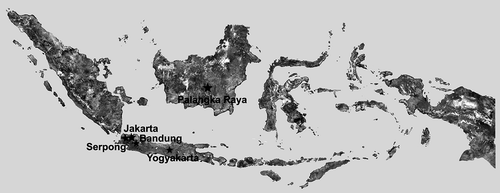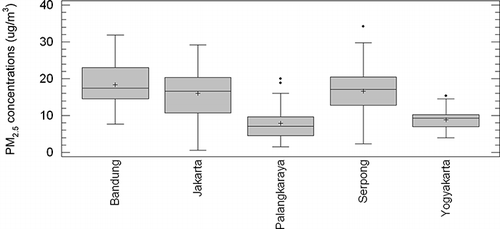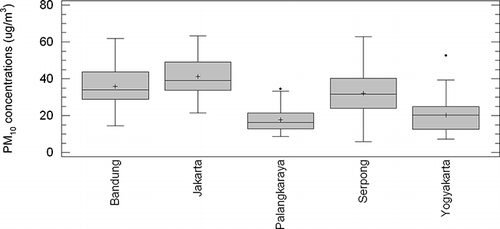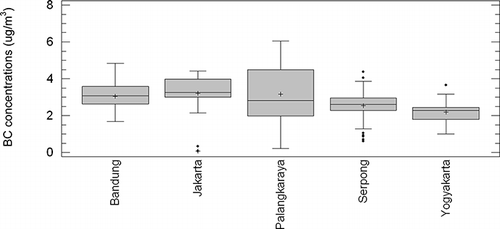Abstract
Samples of airborne particulate matter were collected at several cities in Indonesia: Bandung, Jakarta, Palangka Raya, Serpong, and Yogyakarta, from January through December 2011. The samples were collected once a week using a Gent stacked filter unit sampler in two size fractions of 2.5 µm (fine, PM2.5) and 2.5 to 10 µm (coarse, PM2.5–10). Black carbon was measured using an EEL smoke stain reflectometer. The average of PM2.5 during the sampling period for Bandung, Jakarta, Palangka Raya, Serpong, and Yogyakarta sites was 18.35, 16.50, 7.74, 16.68, and 8.78 µg/m3, respectively. The average of BC for Bandung, Jakarta, Palangka Raya, Serpong and Yogyakarta was 3.05, 3.37, 3.19, 2.51, and 2.20 μg/m3, respectively. The ratio of the 24-hr BC concentration compared to the PM2.5 concentrations showed that BC comprises about 17–45% of the fine particulate matter collected at all sites. The average percentage of BC in PM2.5 concentrations in Bandung, Jakarta, Palangka Raya, Serpong, and Yogyakarta was 18, 22, 45, 17, and 26%, respectively. Bandung and Jakarta compared with Yogyakarta showed higher concentrations of PM2.5 and BC, which indicated pollution occurring in Bandung and Jakarta is more intense than in Yogyakarta, while the maximum of BC concentration and the percentage of BC in PM2.5 in Palangka Raya were 6.04 μg/m3 and 75%, respectively. This higher BC concentration than the other cities was due to the forest fires that occurred frequently during the sampling period. The contributions of BC source in these cities were also analyzed to ascertain the local sources of BC.
BC in PM2.5 was monitored over the period of January–December 2011 in several big cities in Indonesia to provide quantitative information on BC concentrations and contributions to PM2.5 and for comparison among these cities and with other Asian countries. This study supports the national air quality monitoring projects. The results of black carbon concentrations in these areas indicate source contributions from local sources such as forest fire, biomass burning, and vehicle emissions.
Introduction
Atmospheric aerosols are the dominant contributor to the absorption of light in the visible and in the near-infrared spectral region. Black carbon (BC) is almost exclusively responsible for the light absorption by particles (CitationTaha et al., 2007) and is a major contributor to the fine particulate matter in the atmosphere. The most important sources for atmospheric BC are the burning of fossil fuels, forest fires, and biomass burning. Biomass burning may be the dominant BC source over tropical regions and over most of the southern hemisphere (CitationPakkanen et al., 2000). In Indonesia, the biomass burning factor contributes about 40% of the PM2.5 mass in the suburban area in Lembang and about 20% in the urban area in Bandung (CitationSantoso et al., 2008). In European cities BC is strongly related to traffic, and BC is among the most important contributors to fine particulate matter of both PM2.5 and PM10 (CitationPakkanen et al., 2000).
Pollution caused by airborne particulate matter (APM) in several cities in Indonesia has become worse due to economic activities, rapid population growth, urbanization, and industrialization. It is now being recognized as a national problem with a serious impact on human health. In Indonesia, air quality monitoring for PM2.5, especially carbonaceous particles, is still limited. There are regions within Indonesia that experience episodes of degraded air quality due to peat forest fires, such as Palangka Raya and Pekanbaru. Recently, the authorities of environmental agencies in these areas have shown a strong motivation to understand the key variables that are responsible for these periods. Several cities have started periodical monitoring of air quality for fine particulate matter as a national project in Indonesia. The Minister of the Environment is aware of this situation, and there is an effort to propose new air pollution regulations to improve the air quality. Regulations related to the anthropogenic emissions have also been made, for example, the banning of open burning in public areas. However, these regulations need scientifically based research, to provide reliable information related to the air pollution degradation and influencing parameters.
In this study, the BC and PM2.5 concentrations collected in five cities in Indonesia (Bandung, Jakarta, Palangka Raya, Serpong, and Yogyakarta) were determined by reflectance measurement using a smoke stain reflectometer (Diffusion Systems Ltd. model 43D). A comparison between several cities in Indonesia is presented. The purpose of this study is to provide quantitative information of BC concentrations in several cities in Indonesia, its contributions to PM2.5, and estimation for the source of BC concentrations.
Methodology
Samples of airborne particulate matter were collected in five cities located on Java and Borneo islands. The samplers on Java island were placed in Jakarta, Serpong, Bandung and Yogyakarta, while on Borneo the sampler was placed in Palangka Raya. Jakarta (latitude 6˚12’S, longitude 106˚48’E) is the capital and largest city of Indonesia. Located on the northwest coast of Java island, it has an area of 661.52 km2 (255 sq mi). Jakarta is the country's economic, cultural, and political center, and it is the most populous city in Indonesia, with many buildings, highways, and small- to large-scale factories located in and around the city. In general, Indonesia has two seasons, dry season (April to September) and wet season (October to March). The rapid growth of industry, population, and motor vehicle usage has strongly affected the city's environmental quality. Motor vehicles contribute nearly 13–44% of suspended particulate matter (SPM) into the air in Jakarta (CitationWALHI, 2007). Meanwhile, the growth rate of motor vehicle numbers in Jakarta is 15% per year, so that for 2015 the estimated number of vehicles in Jakarta is about 15 million (CitationBAPPENAS, 2006). Serpong is a district of South Tangerang, an independent city of Banten province, and categorized as an industrial city with a population of more than 14,000 inhabitants in an area of approximately 24 km2. Bandung is the provincial capital of West Java and Yogyakarta is the provincial capital of Yogyakarta special region. Palangka Raya is the provincial capital of central Borneo. The sampling locations are shown in
The samples were collected once a week using a Gent stacked filter unit sampler in two size fractions of 2.5 µm (fine, PM2.5) and 2.5 to 10 µm (coarse, PM2.5–10) (CitationHopke et al., 1997). The coarse fraction samples were collected on an 8.0-μm-pore Nuclepore filters, whereas the PM2.5 samples were collected on 0.4-μm-pore Nuclepore filters. Sampling was performed at a flow rate of 15–18 L/min for 24 hr during 2011. In total, 42, 62, 32, 49, and 43 pairs of samples were collected in Jakarta, Serpong, Bandung, Yogyakarta, and Palangka Raya respectively. Sampling in Serpong during April–May 2011 was done twice a week.
The masses of fine and coarse fractions were determined by weighing the filters before and after exposure; then they were divided by the volume of air passing through the filter to obtain the concentrations of PM2.5 and PM2.5–10 (μg/m3). The PM10 concentration was obtained by summing these two values. The black carbon concentrations of the samples were determined by reflectance measurement using a smoke stain reflectometer (Diffusion Systems Ltd. model 43D). Secondary standards of known black carbon concentrations are used to calibrate the reflectometer.
Results and Discussion
All samples were collected on weekdays during 2011. shows the mean and range of values of the PM2.5, PM10 and black carbon mass concentrations for the five cities. The mean values of PM2.5 concentration in Bandung, Jakarta, Palangka Raya, Serpong, and Yogyakarta sites were 18.35, 16.50, 7.74, 16.68, and 8.78 µgm−3, respectively, while the mean values of PM10 concentration were 35.81, 41.58, 17.58, 32.05, and 20.13 µgm−3, respectively.
Table 1. The mean and range of PM2.5, PM10 and BC concentrations
The mass concentrations of PM2.5 and PM10 at the five sites are compared in and The box represents 25 to 75% of the value. The horizontal bar in the box indicates the median and the plus symbol (+) denotes the mean data. The points lying outside the range defined by the whiskers are plotted as outlier dots. It can be seen that the annual averages of PM2.5 mass in Bandung, Jakarta, and Serpong during the collection periods were higher than the Indonesian ambient air quality standard (15 µg/m3) (CitationGovernment Regulation, 1999) and the U.S. Environmental Protection Agency-recommended standard, which is also set at 12 µg/m3, while in Yogyakarta and Palangka Raya sites, the values were lower than the standard. The concentration distributions of PM2.5 in 14 countries in the Asian region during 2002–2005 also indicate that the air quality in many urban areas fail to meet the standards (CitationHopke et al., 2008). The PM2.5 concentrations for Bandung and Jakarta are higher compared with Yogyakarta, which indicated that Bandung and Jakarta are more polluted than Yogyakarta. The PM10 concentrations in Bandung, Jakarta, and Serpong sites were also higher than for Yogyakarta and Palangka Raya. It should be noted that the numbers of industrial activities in Yogyakarta and Palangka Raya were less than in Jakarta, Bandung, and Serpong. The rapid growth of industry, population, and motor vehicle usage in Bandung, Jakarta, and Serpong has strongly affected the city's environmental quality. The imbalance between the number of motor vehicles and available roads has created traffic problems in almost every section of these cities, and has caused the air quality deterioration.
The average concentrations of BC in Bandung, Jakarta, Palangka Raya, Serpong, and Yogyakarta were 3.05, 3.37, 3.19, 2.51, and 2.20 μg/m3, respectively, while the average percentages of BC in PM2.5 concentration at these sampling sites were 18, 22, 45, 17, and 26%, respectively. These concentrations are operationally defined based on the amount of reflected light that is absorbed by the filter sample and an assumed mass absorption coefficient (7 m2/g, with exposed area 12.57 cm2) to convert reflectance measurement to micrograms per cubic meter. A linear response of absorption (BC) against elemental carbon (EC) even in high concentrations is still obtained (CitationSalako et al., 2012). The average BC concentrations at these sites were lower than other sites in Asian countries, such as Bangladesh, Philippines, and Sri Lanka (CitationHopke et al., 2008). The concentrations of BC from the same sites in Bandung in the period of 2002–2005 were reported by CitationHopke et al. (2008). BC sources in Bandung have been studied previously by CitationSantoso et al. (2008) and showed that the important BC source was biomass burning. In Serpong, CitationSantoso et al. (2011) showed that BC originates from diesel vehicles and biomass burning mixed with road dust. For Jakarta, the BC sources were attributed to motor vehicles since the sampling site in Jakarta was located near one of the busiest arterial roads in Jakarta. For Yogyakarta, the contributions of the various sources to BC concentrations are poorly known and further study related source apportionment and source identification is needed.
shows that the concentrations of BC at these sampling sites are in a similar range of values, except for Palangka Raya where a high concentration of BC was observed. The maximum BC concentration and percentage of BC in PM2.5 in Palangka Raya were 6.04 μg/m3 and 75%, respectively. The BC concentration in Palangka Raya was higher than in the other cities due to forest fires during the dry season of the sampling periods. During August to November 2011, thick haze from forest fires blanketed much of Borneo, affecting major cities like Palangka Raya (Citation Jakarta Globe, 2012). Studies have shown that the “blackness” of the deposit depends on location with respect to the distance to traffic and the sources of particles (CitationJeong et al., 2004).
Conclusion
This study has quantified the PM2.5, PM10, and black carbon concentration at five cities in Indonesia during 2011. The mean PM2.5 mass concentration ranged from 7.74 to 18.35 μg/m3. The annual averages of PM2.5 mass in Bandung, Jakarta, and Serpong during the collection periods were higher than the Indonesian ambient air quality standard. The average percentage of BC in PM2.5 concentration in these sampling sites ranged from 17 to 45%. The maximum BC concentration in Palangka Raya was higher than in the other cities, due to forest fires.
Acknowledgment
The authors extend their thanks to all the staff members in Radiometry Analytical Techniques group in BATAN Bandung and PUSARPEDAL Environmental Management Center, Ministry of Environment for their technical assistance. This work is financially supported by National Nuclear Energy Agency of Indonesia (BATAN) and the International Atomic Energy Agency.
References
- BAPPENAS, National Development Planning Agency. 2006. National/Local Strategy and Action Plan for Urban Air Quality Improvement http://udarakota.bappenas.go.id (http://udarakota.bappenas.go.id)
- Government Regulation, 1999. National Air Ambient Quality Standard—Indonesia, PP no. 41/1999 http://puu-pi.menlh.go.id/pdf/ind/IND-PUU-3-1999-PP-41-1999.pdf (http://puu-pi.menlh.go.id/pdf/ind/IND-PUU-3-1999-PP-41-1999.pdf)
- Hopke , P.K. , Xie , Y. , Raunemaa , T. , Biegalski , S. , Landsberger , S. , Maenhaut , W. , Artaxo , P. and Cohen , D. 1997 . Characterization of the gent stacked filter unit PM10 sampler . Aerosol Sci. Technol. , 27 : 726 – 35 . doi:10.1080/02786829708965507
- Hopke , P.K. , Cohen , D.D. , Begum , B.A. , Biswas , S.K. , Ni , B.F. , Pandit , G.G. , Santoso , M. , Chung , Y.S. , Davy , P. , Markwitz , A. , Waheed , S. , Siddique , N. , Santos , F.L. , Pabroa , P.C.B. , Seneviratne , M.C.S. , Wimolwattanapun , W. , Bunprapob , S. , Vuong , T.B. , Hien , P.D. and Markowicz , A. 2008 . Urban air quality in the Asian region . Sci. Total Environ. , 404 : 103 – 12 . doi:10.1016/j.scitotenv.2008.05.039
- Jakarta Globe. 2012 http://www.thejakartaglobe.com/home/indonesian-haze-spreads-as-forest-fires-continue-to-burn/460332 (http://www.thejakartaglobe.com/home/indonesian-haze-spreads-as-forest-fires-continue-to-burn/460332) (Accessed: August 2012 ).
- Jeong , C.H. , Hopke , P.K. , Kim , E. and Lee , D.W. 2004 . The comparison between thermal-optical transmittance elemental carbon and aethalometer black carbon measured at multiple monitoring sites . Atmos Environ. , 38 : 5193 – 204 . doi:10.1016/j.atmosenv.2004.02.065
- Pakkanen , T.A. , Kerminen , V. , Ojanen , C.H. , Hillamo , R.E. , Aarnio , P. and Koskentalo , T. 2000 . Atmospheric black carbon in Helsinki . Atmos. Environ. , 34 : 1497 – 506 . doi:10.1016/S1352-2310(99)00344-1
- Salako , G.O. , Hopke , P.K. , Cohen , D.D. , Begum , B.A. , Biswas , S.K. , Pandit , G.G. , Chung , Y.S. , Abd Rahman , S. , Hamzah , M. S. , Davy , P. , Markwitz , A. , Shagjjamba , D. , Lodoysamba , S. , Wimolwattanapun , W. and Bunprapob , S. 2012 . Exploring the variation between EC and BC in a variety of locations . Aerosol Air Qual. Res. , 12 : 1 – 7 .
- Santoso , M. , Hopke , P.K. , Hidayat , A. and Dwiana , L.D. 2008 . Sources identification of the atmospheric aerosol at urban and suburban sites in Indonesia by positive matrix factorization . Sci Total Environ. , 397 : 229 – 38 . doi:10.1016/j.scitotenv.2008.01.057
- Santoso , M. , Diah , D.L. , Rita , M. , Esrom , H. , Halimah , S. , Markwitz , A. and Hopke , P.K. 2011 . Preliminary study of the sources of ambient air pollution in Serpong, Indonesia . Atmos. Pollution Research , 2 : 190 – 96 . doi:10.5094/APR.2011.024
- Taha , G. , Box , G. , Cohen , D.D. and Stelcer , E. 2007 . Black carbon measurement using laser integrating plate method . Aerosol Sci. Technol. , 41 ( 3 ) : 266 – 76 . doi:10.1080/02786820601156224
- WALHI. 2007. Advokasi Pencemaran Udara http://walhijabar.wordpress.com/2007/12/31/advokasi-pencemaran-udara-2 (http://walhijabar.wordpress.com/2007/12/31/advokasi-pencemaran-udara-2) (Accessed: October 5, 2010 ).



